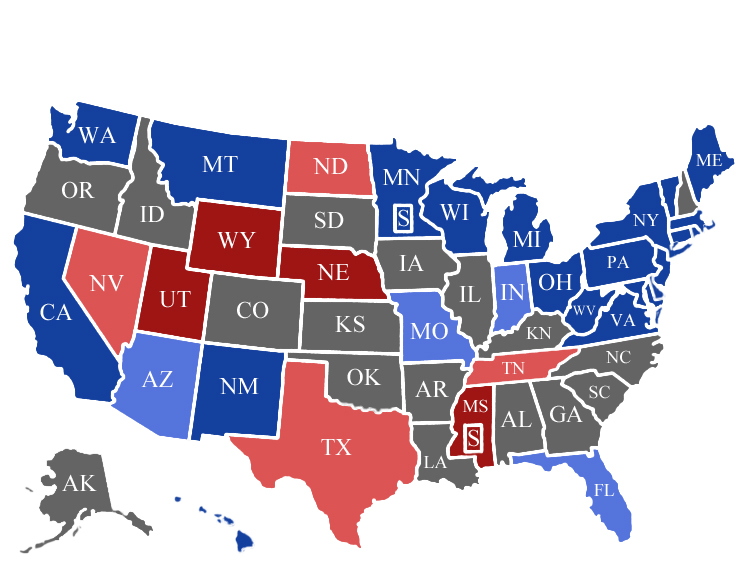Carter Hanson’s Official Election Predictions #1 – The Senate
November 1, 2018
It’s five days out from the 2018 Midterm Elections. 35 seats in the Senate, 36 Governors, all 435 seats in the House of Representatives, all 99 State Legislative bodies, 155 state ballot measures, and innumerous local and county initiatives will be voted on by Americans on Nov. 6.
Over the course of the remaining days before the election, I’ll be going through each of those five ways of looking at the election—Senate, Governors, House, Legislatures, and ballot initiatives—one per day starting with the Senate.
This is your guide to breaking those elections down as well as my forecasts for the most probable way that night will unfold. My predictions, of course, are a best guess, so take everything I propose with a grain of salt. I can’t see the future; this is merely my conjecture based on the polls, historic trends and fundraising numbers, as well as a number of other diverse elements.
The Senate

In the Senate, the GOP looks ready to hold onto its majority after Democrats had a strong running at taking the body. Despite this being a swing democrat year, Republicans will probably at least hold onto their 51 seats, if not gain two or three. This is a unique situation in a wave midterm: when a party has an eight or nine point lead in the generic ballot, they are usually set to gain upwards of 10 Senate seats. Not so this year.
The cause of this divergence in the House and Senate elections, in my opinion, is mostly due to the composition of the Senate seats up: Democrats have to defend in 10 states that voted for Trump in 2016 (MT, ND, WI, MI, OH, IN, WV, PA, MO & FL) and are forced to rely on states like Arizona, Nevada, Texas and Tennessee to make up the already diminished difference.
That’s why I predict the GOP will hold the Senate: the Democrats would have to have a perfect night in order to have a chance at holding all their seats while managing to pick up two other seats. The most likely scenario is the composition remaining roughly as it is with a 51/49 split or the GOP picking up a seat making it 52/48.
However, the Democrats look like they will hold most of those 10 states that voted for Trump in 2016. The exception is North Dakota where Democratic incumbent Heidi Heitkamp has fallen behind after the Kavanaugh Hearings and a series of voter ID laws targeting the critical Native American vote in the state. North Dakota was already looking close before Kavanaugh—Heitkamp was barely elected in 2012 by a few thousand votes—but she’s since fallen behind.
That complicates the math for Democrats as they would then have to flip three Senate seats instead of the already hardly probable two they initially had to focus on. The easiest flip for them is Arizona, where Democrat Christine Sinema is polling consistently ahead of Republican Martha McSally by a couple of points. I think Sinema is more likely to win, but it’s close enough that it could still go either way.
Nevada, on the other hand, is the most frustrating competition for Democrats as they should be able to unseat incumbent Republican Dean Heller without too much difficulty. However, the polls have proven to be more inelastic than previously thought and Heller has held his lead. This forces Democrats to rely on minority and youth turnout, a force that is unpredictable and unreliable, and convincing argument for the GOP to hold onto this seat.
That leaves Texas and Tennessee, a new battleground that has obsessed Democrats and the media like no other races. I like Beto O’Rourke as much as the next guy, but he won’t win. He won’t. Texas will not go blue. The Texas electorate has a massive Republican base, an inelastic pro-GOP unaffiliated electorate, and an unreliable Democratic population. Even in a Democratic wave year, O’Rourke is polling consistently behind Cruz. I understand the demographic shift that has occured in Texas over the past decade but until those people start turning out to vote and becoming a reliable electorate, their impact on these elections won’t be definitive or, frankly, important. At this point I’m unconvinced that we’ve seen Latinos and 18-25 year olds, the critical groups democrats need in order to win, turnout in the numbers necessary for a Democrat to win a statewide race. The Texas 23 House District, along the border with Mexico south of El Paso beside the Rio Grande, should be a likely—if not solid—Democratic district because of the majority latino composition of its population: it voted for Hillary Clinton back in 2016. But we’re seeing the opposite happen: it is an almost certain Republican hold. Until the people of TX-23 get their vote in, Texas will not vote for a Democrat. O’Rourke ran the right kind of campaign but it all depends on minority turnout, so I’m calling it for the GOP.
Tennessee, on the other hand, is a state that hasn’t been covered enough: I think Democrat Phil Bredesen has a greater chance than we give credence. Bredesen has already won statewide election, having been elected Democratic governor of the state. This means that he has name recognition and has a reputation for being a moderate. Marsha Blackburn, conversely, is well known to be a unabashed Trumpian, something that I think won’t play to her advantage to the extent she’s relying on in order to win. However, it’s still Tennessee, an extremely Republican state. There’s no key demographic Democrats can target to the point where they would flip the election like they can in Georgia, New Mexico, or North Dakota. That’s why I still think the GOP will hold this seat, though it will be a lot closer than the Republicans think.
That’s all for today. See you tomorrow for my Governor predictions.














